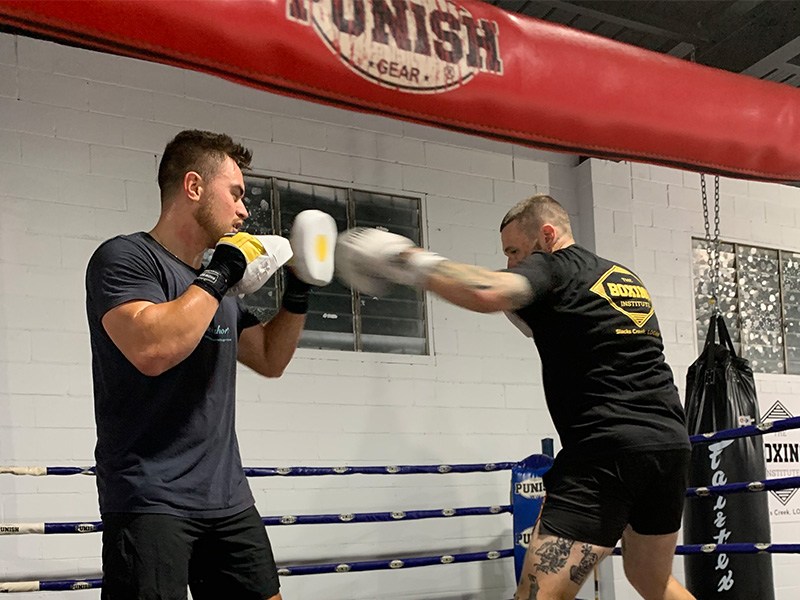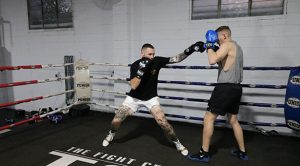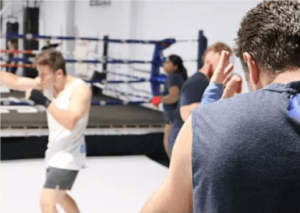
As a trainer, I am repeating myself constantly to my students. Generally speaking, beginners all make very similar mistakes. There are many different aspects of boxing that need working on along the way, but in the beginning there are always similarities.
As with most things, people do not intentionally do boxing techniques incorrectly. Not only am I repeating the same things to beginners frequently, but also telling the same person the same thing over and over again. This is not because they aren’t listening, it’s because they are very unaware that what they are doing is incorrect. So as a trainer, I must learn to be patient. Most students come to my gym to learn, and if they have an ulterior motive such as trying to feed their egos or wanting to hurt people, they do not last long at all.

Here are the three most common things that I find myself repeating to my students:
1. Relax
Boxing, Muay Thai, and Jiu Jitsu (and likely all combat sports) are all about repetition. Practicing the movement over and over again, until it becomes part of your muscle memory so you don’t have to think about it when you want to use the technique. What makes it difficult to practice the movement repetitively is being so tense through your muscles that after a few repetitions you are too tired to continue. This also applies in fights. If you are too tense and engaging all your muscles in a fight so that they work against each other, you will not last longer than the first round. When we throw strikes we are trying to only engage the muscles that matter in an effort to conserve energy. This way we learn to hit hard but in an efficient way.
Understandably, it is very hard to relax in the beginning. This is why at TFC (The Fight Centre – Muay Thai) and TBI (The Boxing Institute – Logan Boxing) we encourage our students to spend a few weeks of learning the basics; hitting focus pads and the bag before jumping into sparring. The more controlled we keep the environment, the more we can control our body.
When practicing our strikes in a controlled environment where you are hitting something such as a focus pad or the heavy bag, it is easier to make corrections to a beginners technique. It is a far less stressful situation on a beginner compared to when someone is trying to hit them back, so this is a great opportunity for a trainer to get students to relax while still being able to hit hard.

2. Go lighter
Somewhat related to the first topic, but worth diving into deeper as I say it so often to beginners. “Go lighter” is usually said when partners are drilling techniques on each or in sparring, rather than pads/heavy-bag.
It is not a case of sink or swim when it comes to sparring. It is more a case of trying to burn the right habits in so that when the strikes come at us, we react accordingly rather than on instinct. When we burn in the correct reaction repetitively it becomes part of our reflexes. This is exactly what we want to happen, as fighting is just a series of reflexes. There is such little time to think and in the moment when someone tries to strike us, so we need our movements to become automatic.
Oftentimes, a beginner will think they are not going hard when in actual fact they are so tense and have no understanding of how to spar lightly, that it comes across aggressive to whoever they are sparring with. I cannot count the amount of times I tell students to go lighter in sparring, and they both think the other person is at fault for trying to hit too hard.
Once again, usually the beginner has no intention of trying to hurt the other person, but due to their inexperience they end up throwing their shots too hard… and unfortunately sometimes in sparring, things get taken a little more personally than they should be. In an effort to stop this from happening, all of our sparring classes for beginners only have light sparring.
I often say to the beginner sparring classes “I want you to take whatever you think is going “light”, then halve that power again”. We do this in an effort to try and get everyone less fearful of being hit, so they can concentrate on defending properly. If a student is too worried or stressed about the force of their opponents strikes, they will do what comes natural, which is turn their head away and close their eyes to protect their face and eyes. This is one of the most dangerous things a fighter can do, as once they cannot see their opponent, they cannot react and defend strikes properly.
It is important to go light, not only for your own progress, but also for the good of whoever you are partnered up with. Although it is an individual sport, it takes a team to get that fighter prepared for a competition, so students should always respect and help their training partners, sometimes even at the sacrifice of their own short term benefit.

3. Know your intention
This is something that I don’t usually start talking about until a student has a little more experience, but once they do have that experience to understand the concept it gets repeated very frequently.
When I tell a student “know your intention”, I am reminding them that every punch they throw has a specific reason for throwing it. If a fighter begins throwing punches without any intention behind the shots, they all start to become pointless. You can throw a strike many different ways with the same technique but a different intention, and you will have a different outcome for each time.
For example, when I throw a jab, my intention could be;
- keeping my opponent away
- measuring distance for the next punch
- I can throw it aggressively to try and hurt my opponent
- I can throw it as a way of moving my opponents guard to make a clear path for the next strike
- I can use it as a distraction while I move my feet to a better position
There are many reasons I may use a jab, but if I’m unclear on why I’m throwing it then the strike becomes far less effective.
The clearer I am about the desired outcome of the punch, the more likely that desired outcome is likely to happen. Mike Tyson frequently mentioned Cus D’Amato would tell him to throw punches with bad intentions. This means that Tyson didn’t simply just punch hard, he punched with the intention to hurt the other person. The difference is subtle, but creates a big difference in the result.
You can throw a punch at an opponent which is hard and it may not hurt the person. It may just knock them off balance without doing damage. Or, it may land on an ineffective part of their body or guard. Whereas if you throw a punch with the clear intention of trying to hurt the person, then often times your subconscious will make the minor adjustments to take care of the rest (such as accuracy and strength).
You can then have more than one intention. You can throw a punch with the intention of hurting someone, but also have the intention of not exposing yourself to a counter shot.
As the age old boxing saying goes, “we want to hit but not get hit”.
A few others that could have easily made the cut:
- “Keep your hands up”
- “Don’t look away”
- “Remember to breath”
- “Use some aggression”
- “Pick up your feet”
- “Slow it down”
- And funnily enough “do it faster”
… and people wonder why it takes so long to learn boxing when instructions are so clear (just kidding).
Ben Johnston – Fighter and Trainer

